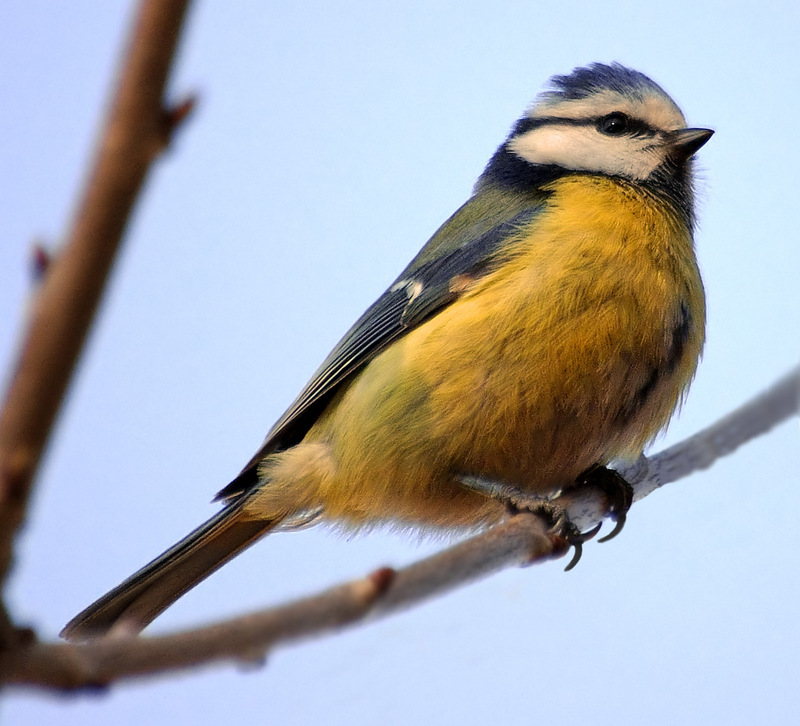Blue tit (Cyanistes caeruleus) - wiki Blue Tit
From Wikipedia, the free encyclopedia
[Photo] This image shows a Blue tit (Cyanistes caeruleus, old Parus caeruleus).
Deutsch: Dieses Bild zeigt eine Blaumeise (Cyanistes caeruleus, fr??her Parus caeruleus). Date 2005-04-02. Author Andr?? Karwath aka Aka http://commons.wikimedia.org/wiki/User:Aka
The Blue Tit, Cyanistes caeruleus (often still Parus caeruleus), is a 10.5 to 12 cm long passerine bird in the tit family Paridae. It is a widespread and common resident breeder throughout temperate and subarctic Europe and western Asia in deciduous or mixed woodlands. It is a resident bird, i.e., most birds do not migrate.
Description
The azure blue crown and dark blue line passing through the eye and encircling the white cheeks to the chin, give the Blue Tit a very distinctive appearance. The forehead, and a bar on the wing are also white.the bar going through the eye is black. The nape, wings and tail are blue; the back is yellowish green; the under parts mostly sulphur-yellow with a dark line down the abdomen. The bill is black, the legs bluish grey, and the irides dark brown. The young are much yellower than the old birds.
This is a common and popular European garden bird, due to its perky acrobatic performances when feeding on nuts or suet. It swings beneath the holder, calling tee, tee, tee or a scolding churr.
The song period lasts almost all the year round, but is most often heard during February to June.
Behaviour
Blue and Great Tits form mixed winter flocks, and the former are perhaps the better gymnasts in the slender twigs. A Blue Tit will often ascend a trunk in short jerky hops, imitating a Treecreeper. As a rule the bird roosts in ivy or evergreens, but in hard weather will shelter in a hole.
The Blue Tit has an average life expectancy of 1.5 years
Diet
The Blue Tit is a valuable destroyer of pests, though it has not an entirely clean sheet as a beneficial species. It is fond of young buds of various trees, and may pull them to bits in the hope of finding insects. No species, however, destroys more coccids and aphids, the worst foes of many plants. It takes leaf miner grubs and green tortrix moths. Seeds are eaten, as with all this family.
Reproduction
It will nest in any suitable hole in a tree, wall, or stump, or an artificial nest box, often competing with House Sparrows or Great Tits for the site. Few birds more readily accept the shelter of a nesting box; the same hole is returned to year after year, and when one pair dies another takes possession.
The bird is a close sitter, hissing and biting at an intruding finger. In the South West of England such behaviour has earned the Blue Tit the colloquial nick-name "Little Billy Biter". When protecting its eggs it raises its crest, but this is a sign of excitement rather than anger, for it is also elevated during nuptial display. The nesting material is usually moss, wool, hair and feathers, and the eggs are laid in April or May. The number in the clutch is often very large, but seven or eight are normal, and bigger clutches are usually laid by two or even more hens.
Learning
An interesting example of culturally transmitted learning in birds was the phenomenon dating from the 1960s of Blue Tits teaching one another how to open traditional British milk bottles with foil tops to get at the cream underneath. This behaviour has declined recently because of the trend toward buying low-fat (skimmed) milk, and the replacement of doorstep delivery by supermarket purchases of milk.
Taxonomy
Most authorities retain Cyanistes as a subgenus of Parus, but the American Ornithologists' Union treats Cyanistes as a distinct genus. This is supported by mtDNA cytochrome b sequence analysis which suggests that Cyanistes in not only distinct, but not close to other titmice (Gill et al., 2005).
The two traditional subspecies found in the Canary Islands (teneriffae) and northwest Africa from northern Morocco to northern Libya (ultramarinus) are distinctive. The Canary Islands subspecies has a black cap, and the African form has a blue back. Research is underway to split these populations into distinct species, with a peculiar "leapfrog" distribution (Kvist et al., 2005; Kvist, 2006; Sangster, 2006):
Afrocanarian Blue Tit, Parus ultramarinus Bonaparte, 1841 (La Palma, Hierro, Fuerteventura, Lanzarote, NW Africa)
Canary Islands Blue Tit, Parus teneriffae Lesson, 1831 (Tenerife, La Gomera, Gran Canaria)
The former would contain three or four subspecies (palmensis, ombriosus and ultramarinus/degener), the latter the nominate subspecies and the unnamed distinct form of Gran Canaria.
Pleske's Tit (Cyanistes × pleskei) is a not uncommonly found hybrid between this species and the Azure Tit in western Russia.
http://en.wikipedia.org/wiki/Blue_Tit
| The text in this page is based on the copyrighted Wikipedia article shown in above URL. It is used under the GNU Free Documentation License. You may redistribute it, verbatim or modified, providing that you comply with the terms of the GFDL. |
